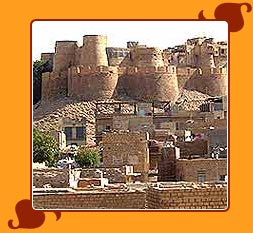Jaisalmer Fort is a monument worth visiting and
worth retaining in your conscious mind. Like various other cities of
Rajasthan, in Jaisalmer too you will find different facets of its own
glorious heritage. Though you can find historical monuments scattered all
over the city, the Jaisalmer Fort will immediately command your attention.

Made
of sand stones and locally known as
Sonar Quila, the Jaisalmer Fort is
a dominating structure amidst sands. The city is said to be founded by
one Raja Rawal Jaisal, a Bhatti Rajput ruler, in approximately 1156 A D.
Legends go by that he did it on the behest of a local hermit named Eesaal.
The raja choose Trikuta hill as the new site for his fort as his earlier
adobe at Luderwa(16 k.m from present Jaisalmer) was too vulnerable to his
comfort. But it should always be kept in mind that these legends are most of
the time product of conscious minds that are very vulnerable to the oriental
exaggeration. Jaisalmer fort is the second oldest in Rajasthan.
Two
hundred and fifty feet tall and reinforced by imposing crenellated sandstone
wall 30 feet high; it has 99 bastions, 92 of which were built between 1633
and 1647. Wells within the fort still provide a regular source of water.
Even today, you will find that nearly one fourth of the old city's
population resides within the fort. If you are a student of cross-cultural
merging, the subtle fusion of Rajput and Islamic architectural styles,
visible in this fort, will catch your fancy. Ganesh Pol, Akshya Pol, Suraj
Pol and Hawa Pol are a must see.
Construction of the
Fort An apt description of the Jaisalmer fort, one of the finest in
the country but one which looks rather incongruous given the desolation
around it. Located bang in the middle of the Thar desert (literal meaning
abode of the dead), it rises like a mirage from the sands, with its huge
turrets pointing skywards. Built in 1156, Jaisalmer is the second oldest of
Rajasthan’s major forts after Chittorgarh. Constructed by Raja Jaisal,
who was searching for a new capital as the earlier one Lodurva was too
vulnerable to invasions, he built the fort and the city surrounding it, thus
fulfilling Lord Krishna's prophecy in the Mahabharata
Located
on a Hilltop Mounted atop Trikuta, the almost triangular
triple-peaked hill, the fort rises like a sunbeam from the desert, 250 feet
tall, and is reinforced by an imposing crenellated sandstone wall 30 feet
high. It has as many as 99 bastions, 92 of which were built between 1633 and
1647 to be used as gun platforms. The view of the 99 bastions of the yellow
sandstone fort, the desert citadel of Raja Jaisal, is spectacular to behold.
The fortifications have grown exponentially over the centuries, and wells
within the confines still provide a regular source of water to the fort.
Palaces
of the MaharawalsAlso, in front of the Chauhata Square lie the
palaces of the Maharawals. Leading up to them is a flight of marble steps
topped by the Maharawal’s marble throne. Nearby lies the five-storeyed
Tazia (metal) Tower, with ornate architecture and Bengali-style roofs. The
five-tiered structure was constructed by Muslim craftsmen who worked on the
building.
The outer defences of the citadel are fortified by
another high wall with a pathway running parallel to the first rampart.
Beyond the entrance is the Ganesh Pol, leading up to the Rang Pol. There was
a time when everyone lived inside the fort itself, protected by its massive
ramparts. As the population of Jaisalmer expanded, people started emigrating
from within the fort’s precincts from about the 17th century. However,
even today the fort is a hive of activity, and you’ll witness a
cross-section of the populace living within it as you travel through its
winding streets and alleys.
Installation of a unique
device The fort also has a peculiar gadget hoisted on top of its
ramparts. Since Met departments were in short supply in those days, this was
used to forecast the weather. Every year in April a flag would be placed in
its centre and, based on the direction in which it blew, the weather for the
entire year was forecast. If it blew northwards it indicated famine, and if
it went westwards Ho the citizenry could rest assured that a fine monsoon
was in the offing. May seem a bit primitive today but the system was
probably just as accurate or inaccurate as the Met office nowadays.
Jaisalmer
Fort -- A Marvel Built in Sandstone Just as the Taj in Agra is
worth visiting on a full moon night, Jaisalmer fort by nightfall is a sight
to behold, it has all the romance and suspense of a Hitchcockian mystery.
You half expect an invading army to march up to the castle, over its
enormous paved flagstones, while those defending the fort shoot missiles at
them from the ramparts. Suffice to say the Jaisalmer fort is one of the
marvels of Rajasthani architecture, particularly of the stone-carver’s
art.






